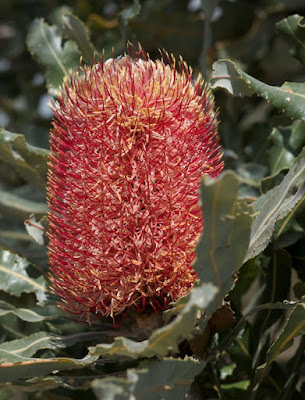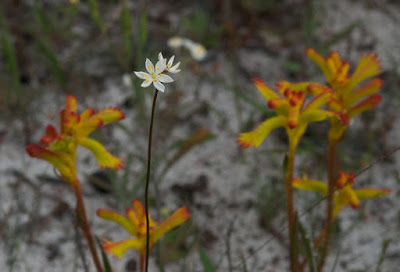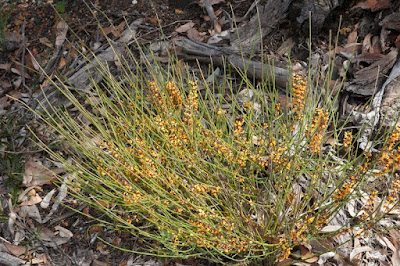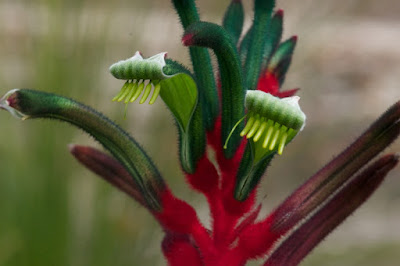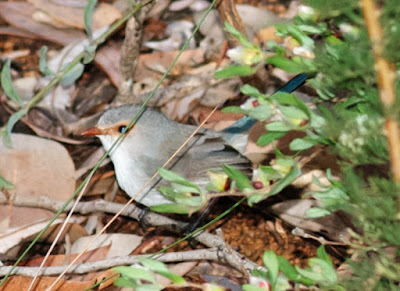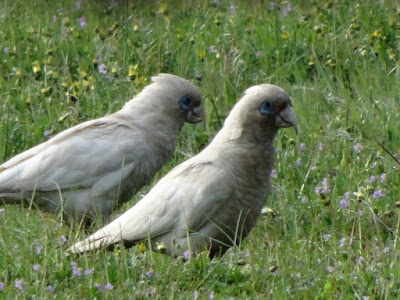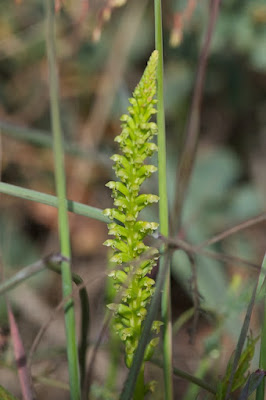The afternoon of September 22, 2013, was our last in Western Australia, and it was time for Eileen and I to think about heading, more or less, in the direction of Perth Airport. That meant, after a final look at the Indian Ocean at Lancelin, heading east again across the sandy coastal heathlands before turning south. It also meant another pass through some very nice wildflower country.
Flowering heads of Firewood Banksia (Banksia menziesii) were conspicuous along our route; this is a common species in the heathlands north of Perth.
Mayweed Sunray (Hyalosperma cotula) is an everlasting daisy, with shorter petals than the everlastings we had seen farther north (though it grows widely in the far west, through most of the regions we had visited on our trip).
Cowslip Orchid (Caladenia flava) was common here, as it had been in many places we had seen on our travels.
Milkmaids (Burchardia sp) flowered in the sand beside Common Catspaw (Anigozanthos humilis).
The Posy Triggerplant (Stylidium crossocephalum) must be one of the most attractive of its genus; its neatly-arranged inflorescences do resemble a bunch of nosegays.
Exotic weeds shared the sandy soil with native plants. This is Pimpernel (Lysimachia arvensis Forma azurea). Pimpernel comes in a variety of colours; in its scarlet form, of course, it has given its name to Baroness Orczy's "demmed elusive" hero. I found it to be pretty elusive itself - not that it was hard to find, but, not realizing it was a weed, it took me a long time to discover its (not so secret) identity.
Lesser Broomrape (Orobanche minor) is one of the stranger-looking weeds in Australia, Broomrapes are root parasites, lacking chlorophyll of their own. The Lesser Broomrape is a European and North African plant, parasitizing peas (Fabaceae) and daisies (Asteraceae). In this photo it has access to both; surrounding it are the yellow flowers of Capeweed (Arctotheca calendula) and, in the foreground, the blue blossoms of a lupine.
The stand of flowers I am photographing with such intense concentration at the top of this post are, I believe, Purple Pansy Orchids (Diuris longifolia), growing on the roadside west of Mooliabeenee. There seems to be some confusion between this species and the Common Donkey Orchid (D. corymbosa), which has largely yellow flowers. Donkey orchids are confusing (certainly to me), so I won't bet that I have the species dead to rights here.
Diuris spp are called donkey orchids for obvious reasons. Oddly, the big donkey "ears" are petals, while the large fan-shaped structure in front of them is a sepal. The other two sepals are the greenish, strap-shaped objects dangling beneath the flower. Donkey orchids are not fragrant, and provide no nectar for their visitors. They may attract pollinators, according to Hoffman and Brown's Orchids of South-West Australia (3rd edition, 2011), by resembling the flowers of various peas growing in the same area; bees visiting the pea flowers may drop in on the orchids by mistake.
Perhaps bees visiting these particular orchids may have been looking for Sphaerolobium medium, a flowering pea growing nearby...
... or, perhaps, for this pea, which I believe to be Daviesia hakeoides.
The verges along the road were overgrown with flowers, highlighted by the bright red stems of kangaroo paws. Now that I'm on my last Western Australian entry, this is probably a good time to commend the state for its enlightened policy of letting its roadsides revert to nature rather than trimming them, as so many countries do, as though they were some sort of enormous lawn. As they are, the value of these wild road edges to plant (and, surely, animal) conservation must be considerable.
Mangles' Kangaroo Paw (Anigozanthos manglesii) is an extraordinary-looking plant, whose features I have enthused over before. It was nice to see it one more time.
Even its shoots look weird, as these photographs show.
We were seeing some now-familar flowers for the last time, too: the drooping sprays of Purple Tassels (Sowerbaea laxiflora)....
...and the intense blues of Blue Leschenaultia (Leschenaultia biloba).
There were new plants to be seen: this is Tufted Lobelia (Lobelia rhombifolia)....
... and this is - well, I don't know what this is!
We drove on, past scenery that could only be Australian: grass trees (Xanthorrhoea sp), looking rather like rejects from a Dr. Who casting call...
...against a background of eucalypts, with their dangling, goblet-like fruits.
At one point we found a Pacific Heron (Ardea pacifica), in my opinion one of the loveliest of its family, stalking through a flooded field.
We had little time, but I persuaded Eileen to let me make one last stop. Though our trip had focused on flowers, I had naturally kept my eye out for the special birds of the southwest. Diligent readers will realize that I had found most of them, but one glaring lacuna remained. To my eye, one of the prettiest Australian birds is the Eastern Spinebill (Acanthorhynchus tenuirostris). It is so common in the east that I assumed that its cousin the Western Spinebill (A. superciliosus) would be an easy find. Instead, it is uncommon and local, and missing it rankled me - so I made a detour into the Avon Valley National Park to see if I could pick it up.
The park protects a lovely banksia-eucalypt woodland, with grass trees (Xanthorrhoea sp) that look, if anything, even more alien than the ones we had seen further up the road,
Bull Banksia (Banksia grandis) dominated the understorey but was not yet in flower, its rough leaves surrounding only last year's dead inflorescences.
Its cousin the Pingle (Banksia (Dryandra) squarrosa), however, was heavily in bloom, and an ideal attractant for reclusive honeyeaters.
There were other flowers waiting for birds to pollinate them: Catkin Grevillea (Grevillea synapheae)...
...and Wilson's Grevillea (Grevillea wilsonii), also known as 'Native Fuschsia' though it has nothing to do with genuine fuschsias.
There were birds, too: a female Splendid Fairy-Wren (Malurus splendens) gave me a last glimpse of one of my favourite bird groups.
And, at last, there were the spinebills. Without a telephoto I could only get a few poor shots, and the colourful male remained excessively coy despite a few playings of his song (you can see bits of him on the right in the lower photograph; otherwise try here). The female, though, was too busy at the Pingle to pay me much notice. There they were, and I was satisfied. It was time to rescue Eileen (waiting patiently in the car), drive to the airport, and leave Western Australia behind.
Pages on this blog
▼
Thursday, July 30, 2015
Monday, July 27, 2015
Australia: Farewell to the West (Part 1)
We awoke refreshed, ready (on September 22, 2013) for our last day in Western Australia. After the previous night's sunset, the two interlocking trees on the hilltop beyond our caravan looked quite different against the morning sky.
After a grateful farewell to our hosts we were off again, following a twisting, roundabout route from Dandaragan back to Perth Airport, taking in what flowers we could on the way (Eileen was, as usual, indulgent as I hopped out of the car at various unlikely spots, eager to photograph yet another batch of plant life).
Flocks of corellas flew past us occasionally, causing me to regret the loss of my now-broken telephoto lens.
I did, however manage to get a closeup of a pair of Western Corellas (Cacatua pastinator) with Eileen's point-and-shoot. notice their long, projecting upper mandibles, a feature once thought to ally this species with the Long-billed Corella (C. tenuirostris) of the east.
As we were driving through almost completely human-modified agricultural country, it shouldn't be surprising that some of the roadside flowers I photographed were, in fact, introduced weeds, with charmless names like Blowfly Grass (Briza maxima). In North America, where this Mediterranean grass also grows widely, it is called Big Quakinggrass, which at least sounds less revolting.
Mind you, some weeds can be pretty gorgeous. A stand of Wild, or Pink, Gladiolus (Gladiolus caryophyllaceus), an introduced weed from South Africa now common in the lower Swan River Valley near Perth, makes a spectacular sight.
Looks, though, can be deceiving, and in Western Australia Wild Gladiolus is considered to be an invasive pest requiring active community management.
Native floers among the weeds included Yellow Buttercups (Hibbertia hypericoides)...
... and the unobtrusive spikes of Common Mignonette Orchid (Microtis media), one of the less impressive Australian orchids. Mignonette orchids are pollinated by small flies and other insects, or pollinate themselves if the insects stay away.
Our route thus far had taken us, mostly, southwards, but now we turned west towards the Indian Ocean coastline, crossing into native heathland between the Namming and Nilgen Nature Reserves east of Lancelin.
Here, once again, native flowers predominated, and the number and variety of available wildflowers began to increase.
Here, again, were stands of tall Acorn Banksias (Banksia prionotes) rising above the surrounding heath.
In the heathland shrub layer we found Pixie Mops (Petrophile linearis), another common heathland protea...
...and this attractive myrtle, presumably a species of Melaleuca, in full flower.
The sandy soil under the shrub layer supported numbers of herbaceous wildflowers, some now familiar and some new.
Common Catspaw (Anigozanthos humilis) was, indeed. common. I've posted a lot of photos of this photogenic plant in the course of describing our travels through Western Australia, but now that we're nearing the end of the trip I hope my readers won't mind a few more.
I also found it hard to resist the metallic flowers of Blue Tinsel Lily (Calectasia grandiflora), a member of the peculiarly southwestern Australian family Dasypogonaceae.
Golden Long-Heads (Podotheca gnaphalioides) still strikes me as a very odd-looking flower to be a member of the composite family (Asteraceae), if only because the individual flowers look like, well, individual flowers instead of parts of a daisy, thistle or dandelion.
This is a species of Trymalium, a small genus of plants confined to Australia's south and southwest. It is member of the buckthorn family (Rhamnaceae).
Hairy Yellow Pea (Gompholobium tomentosum) is one of the more recognizable of the southwest's many peas. Besides its pale yellow colour its inflorescence is noticeably hairy, as this photograph shows rather nicely.
I found two different species of trigger flower (Stylidaceae) here. This one, I believe, is Book Triggerplant (Stylidium calcaratum).
The much more local Pink Fountain Triggerplant (Stylidium brunonianum) is confined to the region around Perth. Its raceme of flowers is quite unlike the single flowers of the Book Triggerplant, but both share the trigger mechanism that snaps down on unsuspecting (well, I assume they are unsuspecting) pollinators; you can see the mechanism quite clearly in the flower facing us in the lower photograph.
By now we had to think about heading south, but we finished the first part of our last day with a quick run to the Indian Ocean coast at Lancelin where I had time for a snap of native pink Coastal Pigface (Carpobrotus virescens) sharing the sand dunes with a few yellow inflorescences of the exotic Capeweed (Arctotheca calendula).
After a grateful farewell to our hosts we were off again, following a twisting, roundabout route from Dandaragan back to Perth Airport, taking in what flowers we could on the way (Eileen was, as usual, indulgent as I hopped out of the car at various unlikely spots, eager to photograph yet another batch of plant life).
Flocks of corellas flew past us occasionally, causing me to regret the loss of my now-broken telephoto lens.
I did, however manage to get a closeup of a pair of Western Corellas (Cacatua pastinator) with Eileen's point-and-shoot. notice their long, projecting upper mandibles, a feature once thought to ally this species with the Long-billed Corella (C. tenuirostris) of the east.
As we were driving through almost completely human-modified agricultural country, it shouldn't be surprising that some of the roadside flowers I photographed were, in fact, introduced weeds, with charmless names like Blowfly Grass (Briza maxima). In North America, where this Mediterranean grass also grows widely, it is called Big Quakinggrass, which at least sounds less revolting.
Mind you, some weeds can be pretty gorgeous. A stand of Wild, or Pink, Gladiolus (Gladiolus caryophyllaceus), an introduced weed from South Africa now common in the lower Swan River Valley near Perth, makes a spectacular sight.
Looks, though, can be deceiving, and in Western Australia Wild Gladiolus is considered to be an invasive pest requiring active community management.
Native floers among the weeds included Yellow Buttercups (Hibbertia hypericoides)...
... and the unobtrusive spikes of Common Mignonette Orchid (Microtis media), one of the less impressive Australian orchids. Mignonette orchids are pollinated by small flies and other insects, or pollinate themselves if the insects stay away.
Our route thus far had taken us, mostly, southwards, but now we turned west towards the Indian Ocean coastline, crossing into native heathland between the Namming and Nilgen Nature Reserves east of Lancelin.
Here, once again, native flowers predominated, and the number and variety of available wildflowers began to increase.
Here, again, were stands of tall Acorn Banksias (Banksia prionotes) rising above the surrounding heath.
In the heathland shrub layer we found Pixie Mops (Petrophile linearis), another common heathland protea...
...and this attractive myrtle, presumably a species of Melaleuca, in full flower.
The sandy soil under the shrub layer supported numbers of herbaceous wildflowers, some now familiar and some new.
Common Catspaw (Anigozanthos humilis) was, indeed. common. I've posted a lot of photos of this photogenic plant in the course of describing our travels through Western Australia, but now that we're nearing the end of the trip I hope my readers won't mind a few more.
I also found it hard to resist the metallic flowers of Blue Tinsel Lily (Calectasia grandiflora), a member of the peculiarly southwestern Australian family Dasypogonaceae.
Golden Long-Heads (Podotheca gnaphalioides) still strikes me as a very odd-looking flower to be a member of the composite family (Asteraceae), if only because the individual flowers look like, well, individual flowers instead of parts of a daisy, thistle or dandelion.
This is a species of Trymalium, a small genus of plants confined to Australia's south and southwest. It is member of the buckthorn family (Rhamnaceae).
Hairy Yellow Pea (Gompholobium tomentosum) is one of the more recognizable of the southwest's many peas. Besides its pale yellow colour its inflorescence is noticeably hairy, as this photograph shows rather nicely.
I found two different species of trigger flower (Stylidaceae) here. This one, I believe, is Book Triggerplant (Stylidium calcaratum).
The much more local Pink Fountain Triggerplant (Stylidium brunonianum) is confined to the region around Perth. Its raceme of flowers is quite unlike the single flowers of the Book Triggerplant, but both share the trigger mechanism that snaps down on unsuspecting (well, I assume they are unsuspecting) pollinators; you can see the mechanism quite clearly in the flower facing us in the lower photograph.
By now we had to think about heading south, but we finished the first part of our last day with a quick run to the Indian Ocean coast at Lancelin where I had time for a snap of native pink Coastal Pigface (Carpobrotus virescens) sharing the sand dunes with a few yellow inflorescences of the exotic Capeweed (Arctotheca calendula).


